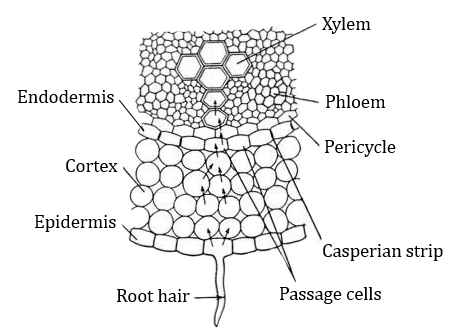
What are passage cells?
Answer
584.1k+ views
Hint: The cells are located in the endodermal region of the roots in the close proximity of the xylem elements. They perform the same function as the term in their name ‘passage’ suggests.
Complete answer:
Passage cells are endodermal cells of older roots that have retained thin walls and Casparian strips instead of becoming suberized and waterproof just like the other cells around them, to continue to permit some symplastic flow to the inside. Experimental evidence suggests that The passage cells function to permit the transfer of solutes like calcium and magnesium into the stele, this has been suggested by experimental evidence. To eventually reach the transpiration system. For the foremost part, however, old roots seal themselves off at the endodermis, and only function a passageway for water and minerals haunted by younger roots "downstream".Thus these cells are referred to as passage cells thanks to its function to move water and minerals salts from the cortex to the xylem elements.
The endodermis prevents water, and any solutes dissolved within the water, from passing through this layer via the apoplast pathway. Water can only undergo the endodermis by crossing the membrane of endodermal cells twice (once to enter and a second time to exit). Water getting into or out of the xylem, which is a component of the apoplast, can thereby be regulated since it must enter the symplast within the endodermis. This allows the plant to regulate to a point the movement of water and to selectively uptake or prevent the passage of ions or other molecules.

Note: -The endodermis does not allow gas bubbles to enter the xylem and helps prevent embolisms from occurring in the water column. Endodermal cells may contain starch granules in the form of amyloplasts. These may function food storage and are shown to be involved in gravitropism in some plants.
-The Casparian strip is a band of cell wall material deposited in the radial and transverse walls of the endodermis. It is chemically different from the rest of the cell wall.
Complete answer:
Passage cells are endodermal cells of older roots that have retained thin walls and Casparian strips instead of becoming suberized and waterproof just like the other cells around them, to continue to permit some symplastic flow to the inside. Experimental evidence suggests that The passage cells function to permit the transfer of solutes like calcium and magnesium into the stele, this has been suggested by experimental evidence. To eventually reach the transpiration system. For the foremost part, however, old roots seal themselves off at the endodermis, and only function a passageway for water and minerals haunted by younger roots "downstream".Thus these cells are referred to as passage cells thanks to its function to move water and minerals salts from the cortex to the xylem elements.
The endodermis prevents water, and any solutes dissolved within the water, from passing through this layer via the apoplast pathway. Water can only undergo the endodermis by crossing the membrane of endodermal cells twice (once to enter and a second time to exit). Water getting into or out of the xylem, which is a component of the apoplast, can thereby be regulated since it must enter the symplast within the endodermis. This allows the plant to regulate to a point the movement of water and to selectively uptake or prevent the passage of ions or other molecules.

Note: -The endodermis does not allow gas bubbles to enter the xylem and helps prevent embolisms from occurring in the water column. Endodermal cells may contain starch granules in the form of amyloplasts. These may function food storage and are shown to be involved in gravitropism in some plants.
-The Casparian strip is a band of cell wall material deposited in the radial and transverse walls of the endodermis. It is chemically different from the rest of the cell wall.
Recently Updated Pages
The number of solutions in x in 02pi for which sqrt class 12 maths CBSE

Write any two methods of preparation of phenol Give class 12 chemistry CBSE

Differentiate between action potential and resting class 12 biology CBSE

Two plane mirrors arranged at right angles to each class 12 physics CBSE

Which of the following molecules is are chiral A I class 12 chemistry CBSE

Name different types of neurons and give one function class 12 biology CBSE

Trending doubts
One Metric ton is equal to kg A 10000 B 1000 C 100 class 11 physics CBSE

What is 1s 2s 2p 3s 3p class 11 chemistry CBSE

Discuss the various forms of bacteria class 11 biology CBSE

State the laws of reflection of light

Explain zero factorial class 11 maths CBSE

An example of chemosynthetic bacteria is A E coli B class 11 biology CBSE




